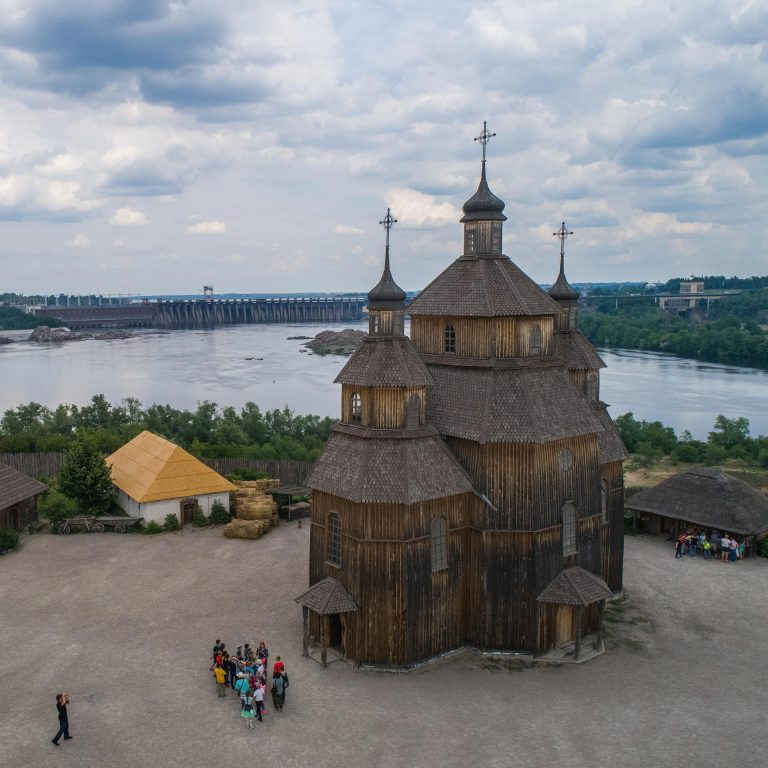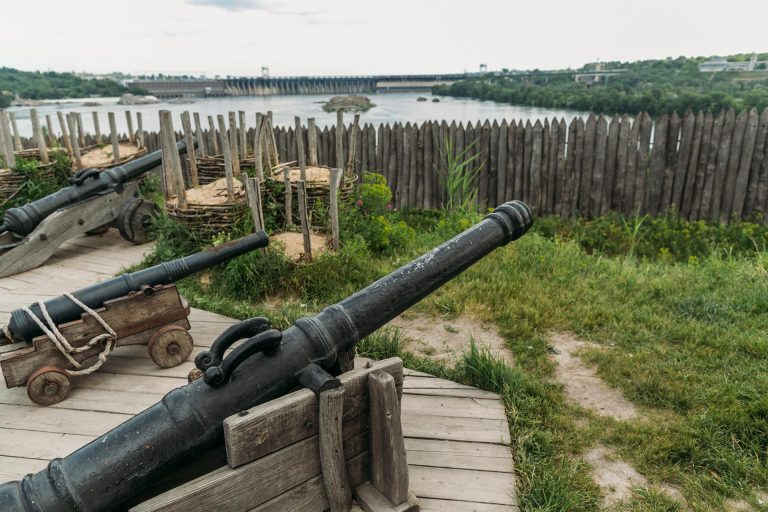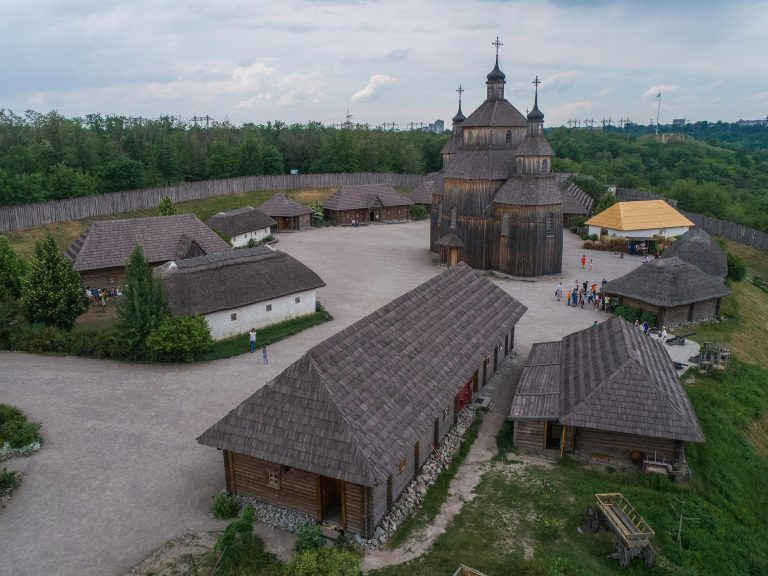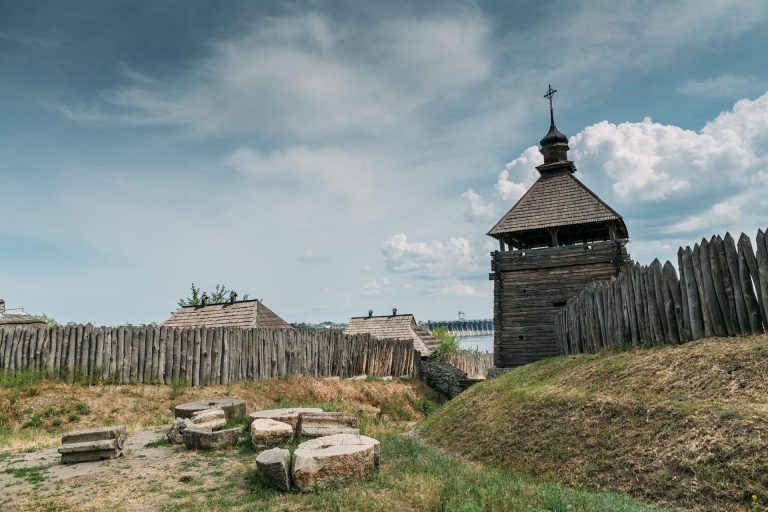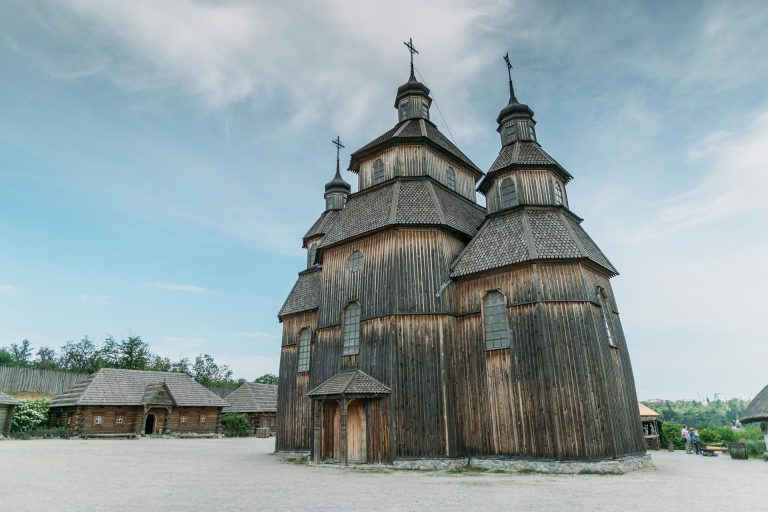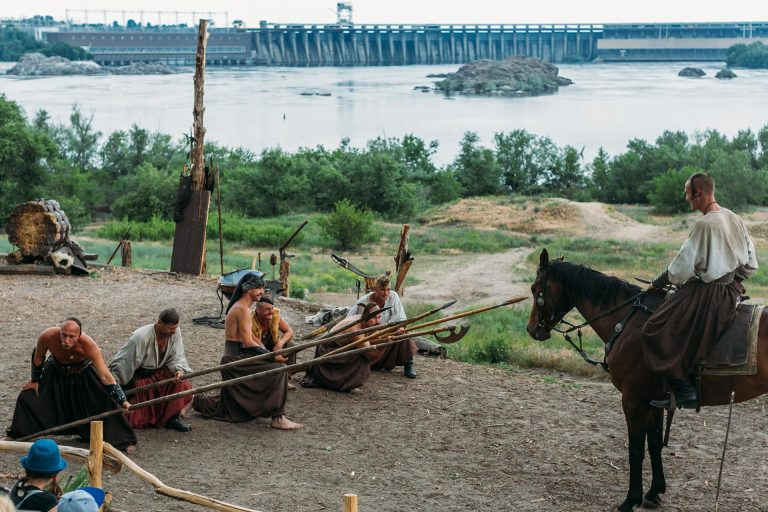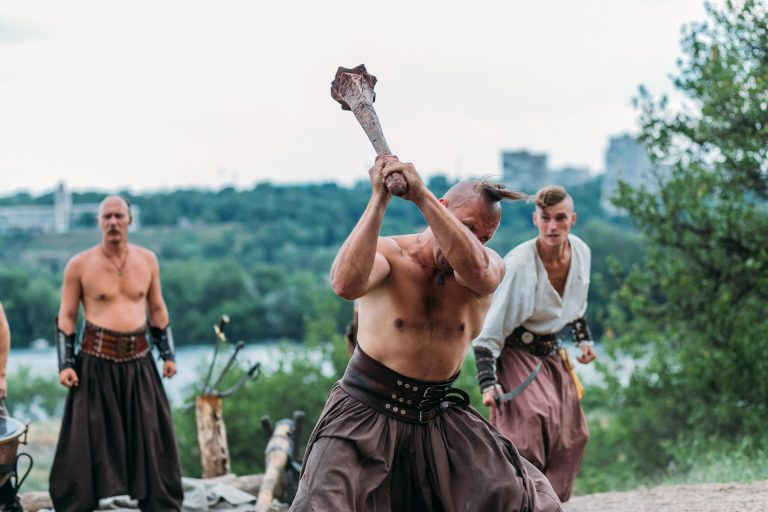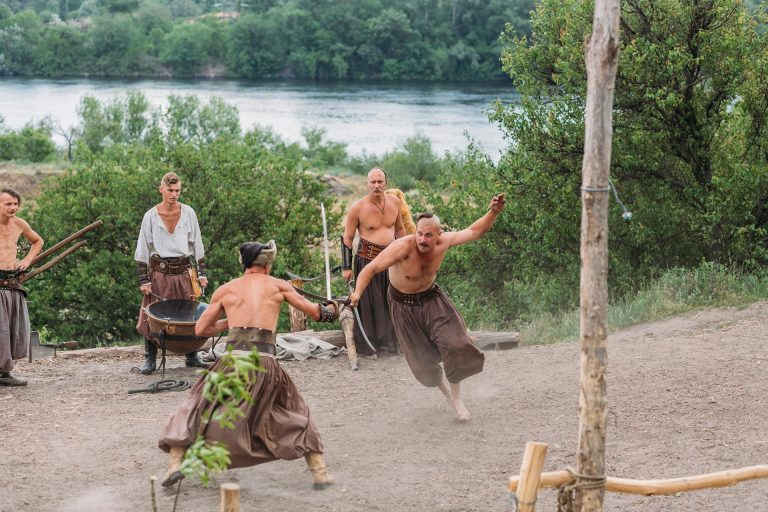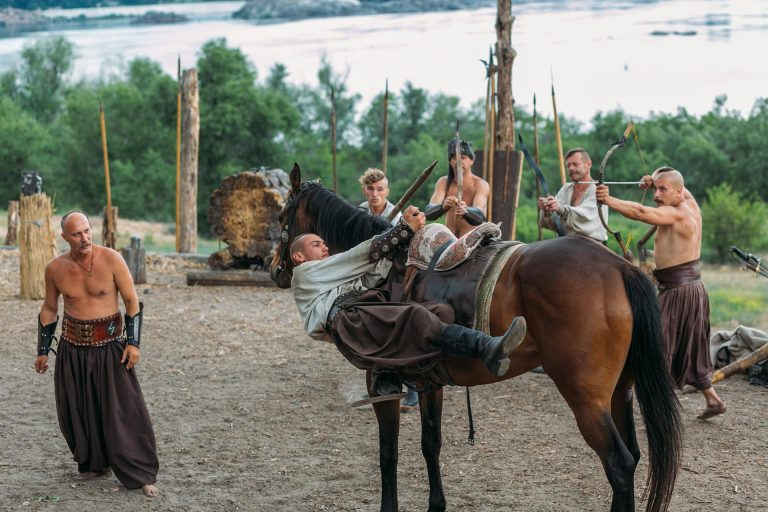Khortytsia, the largest island on the Dnipro river, is located In Zaporizhzhia, below the Dnipro Hydroelectric Power Station. Nowadays this place is gaining importance for the revival of Ukrainian history. Over the past 15 years, the island has got own historic and cultural centre, a museum of navigation, an interactive theatre; while treasures like the thousand-year-old sword that was found here only a few years ago are occasionally discovered here. Nowadays Khortytsia is one of the most important educational, cultural and historical centres of Ukraine and it develops further.
Khortytsia is often called the largest river island in Europe. However, Vyacheslav Zaitsev, researcher, claims that this is not true. The largest river island is Veľký Žitný (“Great Rye island” from Slovak) in the southwest of Slovakia. Khortytsia is 12 km long, while Žitný island stretches for 84 km along the Danube. But Khortytsia inspires myths and is popular due to the Dnipro Rapids — geological structures that surfaced at the Dnipro river bed between the modern cities of the Dnipro and Zaporizhzhia:
— It’s because of the Dnipro Rapids Khortytsia has so many archaeological sites. From here and up to the city Dnipro, there were nine rapids stretched over 70 km. Also, there were zabors and other rocks. Actually, the first written mention of Khortytsia is related to the rapids. The Emperor of Byzantium has written that the Varangians, when passing the rapids near the island Khortytsia, which was called St. George island back then, made sanctuaries under the millennial oaks, paying homage to their gods for a successful trip.
zabors and rocks
Rocks that cause the rapids cross the whole river, while zabor (“fence”) are the structures that cross a river bed only partly.
The largest and most scary among all of the Dnipro Rapids is the Nenasytets, or the Roaring Rapids. Many people died and the ships sank while attempting to cross it:
—When the pilots came there, they put on a clean shirt and read the Lord’s Prayer. Because if you are going to “knock the Uncle Peter’s door” (Peter the Apostle – ed.), which means to die, then you must be in a clean shirt and pray to the Lord. A huge trading route, known as “From the Varangians to the Greeks” was passing along the Dnipro river, and a lot of people were following it. So, thanks to the rapids, there are many burial mounds, fortifications, sanctuaries. Here there are more attractions than in the whole region. These rapids were a gift for us, a gift for Khortytsia.
Almost a century ago, the Soviet leaders decided to build DniproHES (hydroelectric power station) near Khortytsia. Concrete dam raised the water level by almost 40 m and flooded a few dozens of villages on both banks of the Dnipro. All the rapids hid under water and the Dnipro became a regular navigable river:
— Dam of DniproHES was built in 1932. Actually, the ports in the cities Kyiv, Dnipro and Zaporizhzhya can are accessible for ships from the sea only thanks to the dam, because earlier it was impossible to pass the rapids.

There is a commemorative cross on Khortytsia, dedicated to the 500th anniversary of the Zaporizhian Cossacks. Vyacheslav Zaitsev says that the first written mention of the Zaporizhians dates back to 1492, and is related to the fortress Tyagyn of the Duchy of Lithuania, nowadays in the modern Kherson region (the fortress is completely destroyed by now — ed.):
— Turks came to the fortress, but the Cossacks burned one of their galleys. And the Turks wrote to the Lithuanians, asking to calm down their fellows. Counting from that written date, we put this cross in 1992.
There is a common misbelief that the Sich was on Khortytsia, but historians do not confirm this. Dmytro Baida Vyshnevetskyi built Zaporizhzhian Sich on the island of Mala Khortytsia (or Baida), near Khortytsia. On the big Khortytsia island there were Cossack winter dwellings, horses, etc.:
— A novel “Taras Bulba” by Mykola Gogol, and later shooting a movie here, have become a good promotion for Khortytsia. Some people believe that Sich was built here for the movie, but it is not true. The project has been planned already in the 1960s. In fact, the construction of the historical and cultural complex began in 2004-2005. Viktor Yushchenko, who was the President of Ukraine back then, had suggested that “Zaporizhstal”, one of the largest Ukrainian steelmakers, should contribute to such a great project. Indeed, they donated 20 million hryvnias. This was sufficient to build a “skeleton”; the rest of the work was supported by the private sponsors. We are still in the process of finishing the construction, but can’t see the end yet.
Khortytsia island was the first one in Ukraine to get the status of a national reserve. Due to the special location on the island, a unique natural landscape complex has been formed. It is forbidden to make a fire, fish, hunt, or to collect plants here:
— As it turned out, there is one species of insects that lives and feeds on the specific plant species. We also have wild boars, roes, pheasants, deer. Once there was even a moose, but unfortunately, poachers killed it. This is such a microcosm that we need to forbid any interfering with it.

The rocks that are located mainly in the northern and north-western part of Khortytsia are a part of the island’s landscape. The cliffs are 40-50 m high. The rocks Try Stovpy (“Three Pillars”) are located between Khortytsia and DniproHES. The rock that is located furthest from the shore is called Pokhylyi (“Sloping Island”), the closest one — Krislo Kateryny (“Armchair of Catherine”). Seredniy Stovp (Middle Pillar) is between them. Nearby, there is a small rock with a round hollow called the Cossack bowl:
— These rocks also have their own history, but they are definitely not the remains from the rapids, just some rock islands. Try Stovpy are known for their natural formations. Cossack bowl is a cauldron-shaped depression in the rock, which was made by a powerful stream of water. Geologists say these are remains of ancient waterfalls.
In the north of Khortytsia there is also a granite rock that is cut by a deep gorge, which is called the Sich Gates. In that place, the Dnipro splits into two riverbeds: the narrow and rocky Old Dnipro and the broad and spacious New Dnipro, between the left bank and the island. The name of this gorge is associated with the stories about the test for those who wanted to become a Cossack:
— To become a Cossack, one shouldn’t necessarily demonstrate the strength or some kind of boldness. It’s fine if you’re a giant, but if you’re a coward, we don’t need you. As an initiation test for the Cossacks, they put an oak log across the Sich Gates. Those willing to become the Cossacks had to walk the log blindfolded. The Cossack would go, slip, fall upside down, but would be caught below by the others – they were not killers, after all. And then he would become a Cossack. A Cossack is a reckless person who is able to act. This is a brave person, above all.

In 2011, the fisherman has angled an ancient sword near Khortytsia. After the restoration, it turned out that this is one of Ulfber’s swords, dated by the 9-11th centuries. There are no more than 170 such swords in the world, and only warriors of the highest rank could have them. Eighty years earlier, archaeologists have discovered nearby five similar, but much simpler swords, which were most likely lost in a battle. Historians assume that in 972, Kievan prince Sviatoslav Ihorovych had died here, and the discovered Ulfber’s sword belonged to him:
— Sviatoslav was a real knight and did many campaigns at the Volga, Caucasus, Byzantium. One couldn’t distinguish him from his warriors, except that he had a clean shirt. In 972, near Khortytsia, he’d got trapped and died in the battle with the nomadic tribe of the Pechenegs. The fisherman accidentally angled the sword with a hook here, from a depth of 22 meters. This is a legendary sword that was worth a fortune.

At the beginning of the 20th century, there were 129 Scythian burial mounds on Khortytsia, but only 28 of them are preserved by now. The memorial tourist complex dedicated to burial mounds on the island is called “Scythian Stan”. Here are the reconstructed and preserved old burial mounds. The territory of the Scythian Stan is the highest point of Khortytsia. In the past, monumental stone sculptures were put on the mounds — the “babas”:
— Nowadays burial mounds are levelled, but they used to be tall, pointed and with a baba mounted on the top. There is a common mistake that it is a woman (“baba” in Ukrainian means old woman — ed.), but it is not. Baba, in fact, originates from the Turkic and means an old man, a senior warrior. If the stars are visible at night, and the Cossack is lost, he knows that “baba” always faces the east. This is how the saying “walk by the babas” appeared
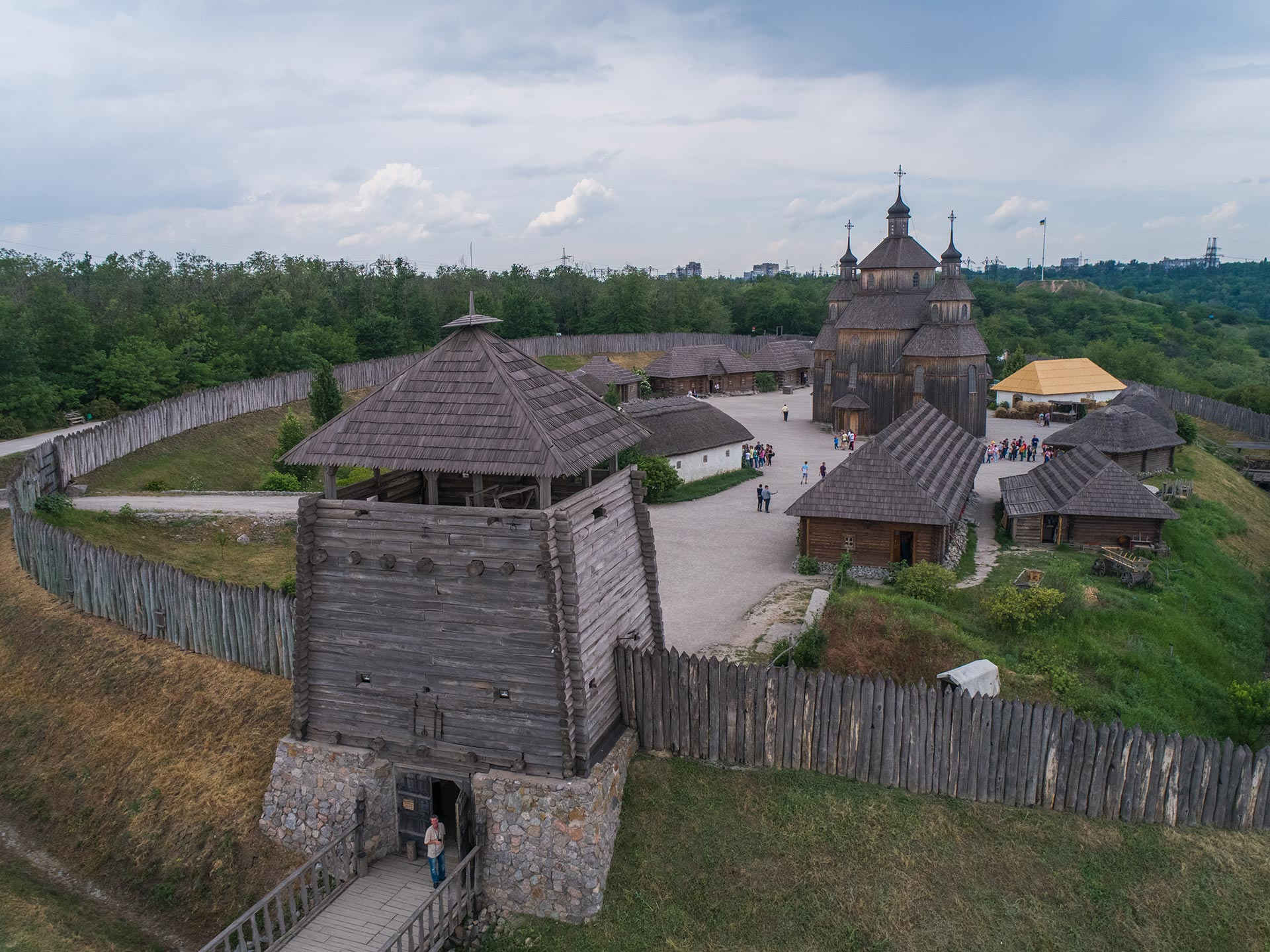
Historic and cultural complex
In the north of Khortytsia there is a museum of the history of the Zaporizhian Cossacks. The museum has exhibits from the history of Khortytsia since ancient times, also numerous artefacts related to the life of the Cossacks. Since 2015, the institution is under reconstruction.
— We will start a full-scale reparation soon. Unfortunately, since the opening in 1983, there was a lot of construction mistakes. The roof leaks and we plan to build another level and make a dome to cover the building completely. We have valuable exhibits — icons, books from the 17th century, and water pours on them. It’s heartbreaking to see it.

Viacheslav Zaitsev believes that modern museums as intermediaries between history and visitors should be reconsidered. The examples of “live” museums can be found both in Ukraine and abroad:
— I was in a Polish museum without any exhibits. There are museums that really provide information without any exhibits. When the museum is dead, with tags, it is some kind of science for the sake of science. I think this is wrong. The museum should work for people, host different events all the time to encourage people to come here and develop, not just get a salary from the ministry and say “My working time is over, good bye.”
A large black stone is in the courtyard of the museum. Viacheslav explains that this artefact is related to the beliefs of the ancient people:
— The nearest deposits of such a stone are in the Cherkasy region. There are no deposits like this here. We brought this Black Stone, or rather one large and a couple of little ones, from the banks of the Dnipro, because some “smart” people started to split pieces from it. The Black Stone is a sanctuary of those times. The petroglyphs were engraved on it. Before the hunting, ancient people hit the stone with a spear for a good luck. Many of his legends are interrelated, but at least I’m a witness that snow does not cover it in the winter, it melts quickly. They say that if you touch the stone or just see it, everything will be okay. At least, I’ve been shot twice, you see, but now I lead this excursion and the whole department.

A museum of shipping “Chaika” (“Seagull”, a name of a Cossack boat — ed.) and the ship workshop are located in the horse hangar on the territory of Khortytsia. The ships of the 17th century are stored there; the local researchers lifted them from the bottom of the Dnipro and restore now:
— These ships participated in the Russian-Turkish war. In the winter of 1738, they returned to Khortytsia, because military camps were here. The whole staff of flotilla died from the plague and about forty ships sank to the bottom of the Dnipro. We lift them up gradually. These are a brigantine, a Cossack “Chaika”, a boat, etc. I think the time will come when we will lift the Turkish galleys, but this requires a lot of money.
During the Russian-Turkish war, a system of fortifications or so-called redoubts was built on the island. All lines of fortifications have been fully or partially preserved. Two redoubts were reconstructed to recreate the original form of fortifications. One of them is located near the Museum of Cossacks, another – near the historical and cultural complex “Zaporizhian Sich”:
— We see an old redoubt near Sich that is 300 years old. It was built in 1736. Inside were soldiers, the redoubt was at the same place where our museum is now, and every two hundred meters there were other redoubts. Of course, it made no sense to attack a redoubt, one should outflank it. Previously a burial mound was there, but it was destroyed and used to make a redoubt. If we think about it as a mound, it is 5 thousand years old.
slideshow
The historical and cultural complex “Zaporizhian Sich”, which represents a generalized picture of the Cossack Sich is located on Khortytsia. Here you can find the most striking elements of the architecture, culture and everyday life of the Zaporizhian Cossacks. The complex is divided into two parts: the inner part (Kish) and the suburbs, where artisan and trade objects are concentrated. On the central square (Maidan) there is the Church of Protection of the Holy Virgin. This is the largest building at the Sich:
— The construction of Sich has started on Pokrova (October 14, 2004, Ukrainian Orthodox feast for Intercession of the Theotokos). The area of our complex is only three and a half hectares, although it should be 50-60 hectares. We have everything reduced in size: the height of the ramparts is around 3-4 metres, and it should be 14 metres, the moat is 2 metres deep instead of 8 metres and so on. There should be around 500 buildings of artisans, with a hundred of them of blacksmiths, but we have only four in total. But please consider that we can not occupy the whole Khortytsia.
Visitors of Khortytsia can attend performance of the Cossack theatre and learn about the military traditions of the Cossacks. Men dressed as Cossacks show how Cossack weapons and equipment were used in practice. Such performances occur about three times per day:
— It’s not my first time to see this show, but something is constantly changed, some new tricks appear. That is, there is no such stable picture as in the cinema. This is a live action. And it’s really interesting.
Video 360
Besides the historical facts, there is a lot of legends about Khortytsia. Viacheslav Zaitsev says, a good legend from the guide is like a dessert after the main dish. Especially, it works for kids, whom you try to give as much information, as possible:
— My task is to entertain them, to tell them stories that would stay with them. So the next generation would become a good successor to us. That’s why we work with schools — because the reserve is not localized here, it expands. We organized seminars for school teachers of history, we show movies in schools.
slideshow
The traces of the Cossack tradition can be found in the modern Ukraine. Viacheslav assumes that such inheritance is reflected in voluntary battalions, in participants of the Revolution of Dignity (2013-2014):
— Voluntary battalions remind me of Cossacks, especially the first mobilization. The guys get these haircuts, tattoos with a trident, Cossacks — it’s all related. The call names are the Cossacks’ nicknames. Everyone there had a nickname — Khortytsia, Nalyvaiko, Balu etc. That’s why a modern army resembles the Cossacks. The Cossacks remind me Maidan (Ukrainian revolution 2013-2014) — it was like the Sich, that kind of self-organisation.
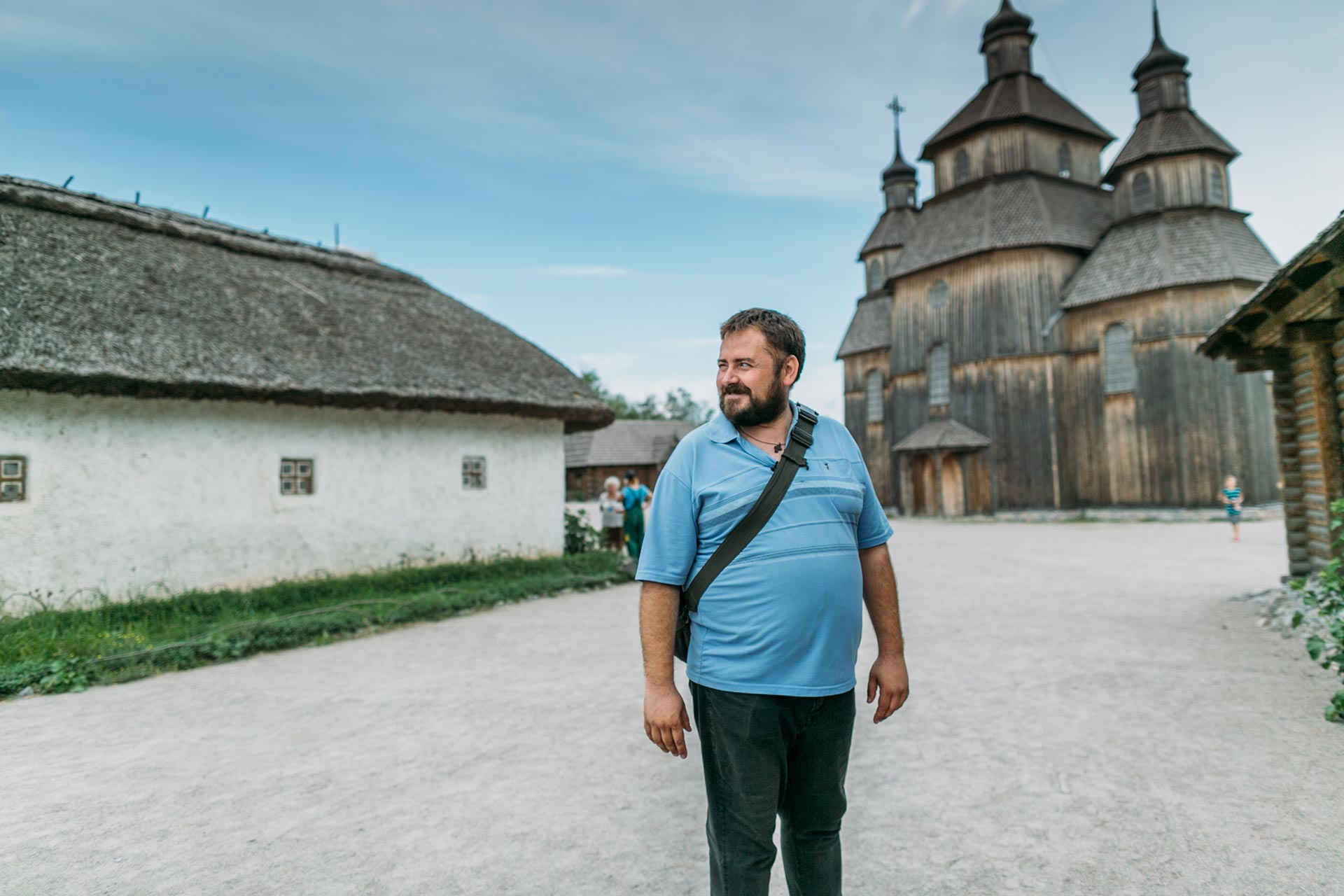
Viacheslav
Viacheslav Zaitsev manages the scientific library and archive of the National Reserve “Khortytsia”. He is a historian and teacher by education, he works in the reserve for more than eight years:
— I was born just a bit down the Dnipro, nearby the city Enerhodar. I came to Khortytsia for the first time as an adult — I was around 23 years old. When I was in school we travelled rarely. So now I am happy when many school kids come for an excursion.
For a year, since March 2014, Viacheslav was a volunteer in the Anti-Terrorist Operation Zone. He was demobilized after the second injury. Nowadays, besides the work in the reserve and teaching, he is also a deputy in Zaporizhzhia City Council, deals with the problems of education, science, youth, sports and tourism.
— I went to the military commissariat and later got into the 79th Air Assault Brigade. I spend a year at war, until March 2015. It was the Battle of Pivdennyi, the Battle of Krasnyi Lyman, the raid for Mariupol, the Airport in Donetsk — twice, Lohvynove near Debaltseve, afterwards, he was at the hospital and then demobilized.
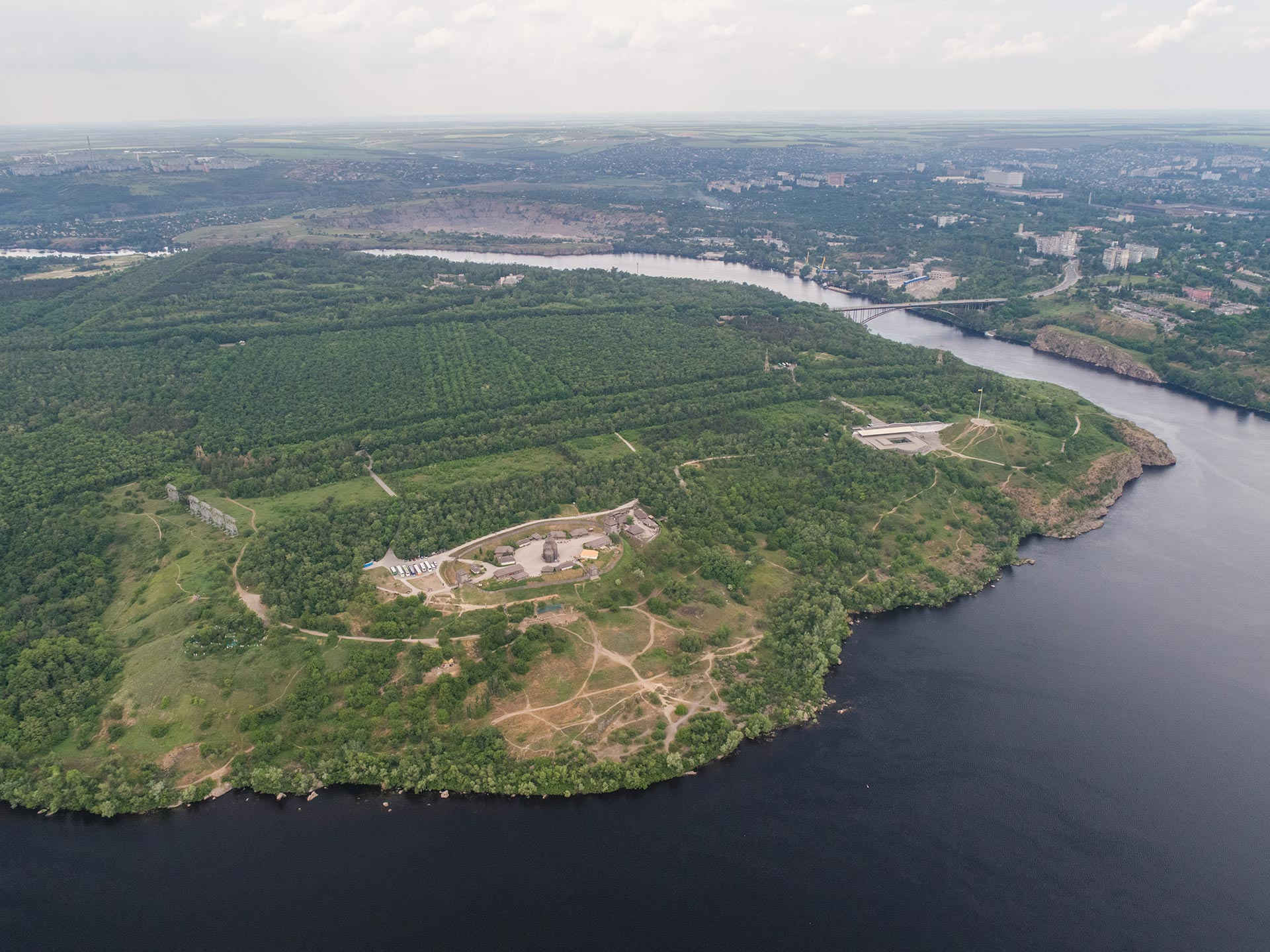
Viacheslav says that he is attracted by the magnitude of Khortytsia: the reserve in the centre of Zaporizhzhia and it is eight times larger than the Central Park in New York and twice the size of the Boulogne Forest in Paris:
— Besides, it’s a great relaxation for me. In the spring, I go to work through the bridge, sweating, but I like it when I come to Khortytsia and hear a nightingale singing. In winter I like that there is no snow in the city, but it still remains on Khortytsia. It’s nice to walk between the spruces. I really appreciate it. I hike up the mound and enjoy these landscapes.

